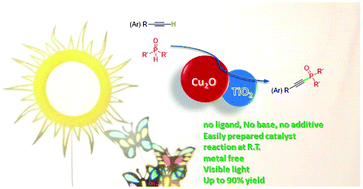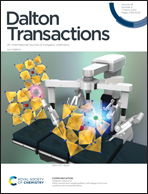TiO2/Cu2O nanoparticle-catalyzed direct C(sp)–P bond formation via aerobic oxidative coupling in air and visible light†
Abstract
The synthesis of organophosphorus compounds is one of the important goals in organic chemistry. Among these compounds, alkynylphosphonates are significantly utilized as the main precursors for the synthesis of biologically active molecules in medicinal chemistry and have attracted extensive interest in the past few decades. Although few efforts have been made towards the direct and atom-economical synthesis of alkynylphosphonates, efforts towards the utilization of visible light as a green and renewable energy source have not been made to date. Here, we have promoted a strategy to construct a type of nano metal oxide composite photocatalyst (Cu2O decorated on TiO2) for the synthesis of alkynylphosphonates via direct C–P bond formation between terminal alkyne and H-phosphonate under visible light irradiation. In this p–n heterojunction photocatalyst, Cu2O acted as a visible-light absorber; moreover, the CB (conduction band) of TiO2 was favorable for accepting a photogenerated electron, and the generated electron hole (e−/h+) pair could initiate the reaction. The present study can provide a new way for the synthesis of this important class of phosphorus organic compounds.



 Please wait while we load your content...
Please wait while we load your content...